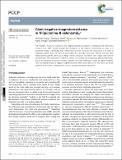Files in this item
Giant negative magnetoresistance in Ni(quinoline-8-selenoate)2
Item metadata
| dc.contributor.author | Black, Nicholas | |
| dc.contributor.author | Tonouchi, Daiki | |
| dc.contributor.author | Matsushita, Michio M. | |
| dc.contributor.author | Woollins, J. Derek | |
| dc.contributor.author | Awaga, Kunio | |
| dc.contributor.author | Robertson, Neil | |
| dc.date.accessioned | 2017-12-21T16:30:17Z | |
| dc.date.available | 2017-12-21T16:30:17Z | |
| dc.date.issued | 2018-01-07 | |
| dc.identifier | 251635248 | |
| dc.identifier | 8c8f16fb-a060-40b4-b234-ed9690f43539 | |
| dc.identifier | 85039412691 | |
| dc.identifier | 000418374800053 | |
| dc.identifier.citation | Black , N , Tonouchi , D , Matsushita , M M , Woollins , J D , Awaga , K & Robertson , N 2018 , ' Giant negative magnetoresistance in Ni(quinoline-8-selenoate) 2 ' , Physical Chemistry Chemical Physics , vol. 20 , no. 1 , pp. 514-519 . https://doi.org/10.1039/c7cp06273g | en |
| dc.identifier.issn | 1463-9076 | |
| dc.identifier.other | ORCID: /0000-0002-1498-9652/work/59464697 | |
| dc.identifier.uri | https://hdl.handle.net/10023/12376 | |
| dc.description | Authors thank the University of St Andrews, the Leverhulme Trust (International Network Grant IN-2012-094) and the JSPS Core-to Core Program, A. Advanced Research Networks for support. | en |
| dc.description.abstract | The magnetic, structural, conductivity and magnetoresistance properties of [Ni(quinoline-8-selenoate)2] ([Ni(qs)2]) have been studied. Despite the insolubility of the material necessitating its study as a powdered sample, a remarkably high conductivity has been measured. The conductivity is an order of magnitude greater than the thin-film processable thiol analogue previously reported and has been interpreted through the same space-charge limited conduction mechanism with charges injected from the electrodes. The introduction of selenium, results in a material with conductivity approaching metallic due to the enhanced interaction between adjacent molecules. Additionally, under an applied magnetic field, the material displays a negative magnetoresistance effect above 35% at 2 K. The effect can still be observed at 200 K and is interpreted in terms of a double-exchange mechanism. | |
| dc.format.extent | 2994887 | |
| dc.language.iso | eng | |
| dc.relation.ispartof | Physical Chemistry Chemical Physics | en |
| dc.subject | QD Chemistry | en |
| dc.subject | NDAS | en |
| dc.subject.lcc | QD | en |
| dc.title | Giant negative magnetoresistance in Ni(quinoline-8-selenoate)2 | en |
| dc.type | Journal article | en |
| dc.contributor.sponsor | The Leverhulme Trust | en |
| dc.contributor.institution | University of St Andrews. School of Chemistry | en |
| dc.contributor.institution | University of St Andrews. Office of the Principal | en |
| dc.contributor.institution | University of St Andrews. EaSTCHEM | en |
| dc.identifier.doi | https://doi.org/10.1039/c7cp06273g | |
| dc.description.status | Peer reviewed | en |
| dc.identifier.url | http://www.rsc.org/suppdata/c7/cp/c7cp06273g/c7cp06273g1.pdf | en |
| dc.identifier.grantnumber | IN-2012-094 | en |
This item appears in the following Collection(s)
Items in the St Andrews Research Repository are protected by copyright, with all rights reserved, unless otherwise indicated.

